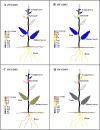Genome-wide analysis of UGDH genes in Populus trichocarpa and responsiveness to nitrogen treatment
- PMID: 33732570
- PMCID: PMC7914333
- DOI: 10.1007/s13205-021-02697-9
Genome-wide analysis of UGDH genes in Populus trichocarpa and responsiveness to nitrogen treatment
Abstract
Plant UDP-glucose 6-dehydrogenase (UGDH) is an important enzyme for the formation of hemicellulose and pectin. Previous studies on UGDH have primarily focused on the biosynthesis of cell wall polysaccharides, while few studies have focused on their regulation by exogenous nitrogen. In the present study, four genes encoding PtUGDH proteins were analyzed by bioinformatics methods. And, the expression profiles of PtUGDH genes under different nitrogen treatments were evaluated with qRT-PCR. The results showed that PtUGDHs have conserved NAD coenzyme binding motif GAGYVGG and the catalytic motif GFGGSCFQKDIL. According to the phylogenetic analysis, PtUGDHs were divided into two subgroups. PtUGDH3 and PtUGDH4 were closely related to AtUGDH1 (important for normal development of Arabidopsis cell wall structure). Chromosomal distribution and genome synteny analysis revealed four segmental-duplicated gene pairs on chr4, 8, 10 and 17. Tissue-specific data from PlantGenIE showed that PtUGDH3 and PtUGDH4 were highly expressed in stems. The qRT-PCR detection showed that the expression of PtUGDH3 in the lower stem and PtUGDH2 of upper leaves were significantly increased induced by low ammonium or nitrate condition. This comprehensive analysis of the UGDH family in poplar provides new insights into their regulation by nitrogen, and would increase our understanding of the roles of UGDHs in hemicellulose and pectin biosynthesis in the cell wall and during poplar development.
Supplementary information: The online version contains supplementary material available at 10.1007/s13205-021-02697-9.
Keywords: Bioinformatics analysis; Expression traits; Nitrogen treatment; Populus trichocarpa; UDP-glucose 6-dehydrogenase.
© King Abdulaziz City for Science and Technology 2021.
Conflict of interest statement
Conflict of interestThe authors declare no competing financial interests.
Figures







Similar articles
-
Identification and expression analysis of the PtGATL genes under different nitrogen and carbon dioxide treatments in Populus trichocarpa.3 Biotech. 2022 Mar;12(3):67. doi: 10.1007/s13205-022-03129-y. Epub 2022 Feb 11. 3 Biotech. 2022. PMID: 35223353 Free PMC article.
-
Genome-wide identification of BXL genes in Populus trichocarpa and their expression under different nitrogen treatments.3 Biotech. 2020 Feb;10(2):57. doi: 10.1007/s13205-020-2061-5. Epub 2020 Jan 22. 3 Biotech. 2020. PMID: 32015953 Free PMC article.
-
Molecular cloning and characterization of a cDNA encoding poplar UDP-glucose dehydrogenase, a key gene of hemicellulose/pectin formation.Biochim Biophys Acta. 2002 Jun 7;1576(1-2):53-8. doi: 10.1016/s0167-4781(02)00292-0. Biochim Biophys Acta. 2002. PMID: 12031484
-
Genome-wide identification of FRK genes in Populus trichocarpa and their expression under different nitrogen treatments.Physiol Mol Biol Plants. 2021 Sep;27(9):1919-1931. doi: 10.1007/s12298-021-01055-6. Epub 2021 Sep 13. Physiol Mol Biol Plants. 2021. PMID: 34616114 Free PMC article.
-
Genome-wide analysis of the RGP gene family in Populus trichocarpa and their expression under nitrogen treatment.Gene Expr Patterns. 2020 Dec;38:119142. doi: 10.1016/j.gep.2020.119142. Epub 2020 Sep 6. Gene Expr Patterns. 2020. PMID: 32898702
Cited by
-
Network Analysis of Metabolome and Transcriptome Revealed Regulation of Different Nitrogen Concentrations on Hybrid Poplar Cambium Development.Int J Mol Sci. 2024 Jan 13;25(2):1017. doi: 10.3390/ijms25021017. Int J Mol Sci. 2024. PMID: 38256092 Free PMC article.
-
ARPI, β-AS, and UGE regulate glycyrrhizin biosynthesis in Glycyrrhiza uralensis hairy roots.Plant Cell Rep. 2021 Jul;40(7):1285-1296. doi: 10.1007/s00299-021-02712-6. Epub 2021 May 17. Plant Cell Rep. 2021. PMID: 34002270
-
Effect of different origins on genes encoding key enzymes involved in the polysaccharide biosynthetic pathway in Hedysarum polybotrys Hand.-Mazz.PLoS One. 2025 Apr 22;20(4):e0317890. doi: 10.1371/journal.pone.0317890. eCollection 2025. PLoS One. 2025. PMID: 40261948 Free PMC article.
-
Identification and expression analysis of the PtGATL genes under different nitrogen and carbon dioxide treatments in Populus trichocarpa.3 Biotech. 2022 Mar;12(3):67. doi: 10.1007/s13205-022-03129-y. Epub 2022 Feb 11. 3 Biotech. 2022. PMID: 35223353 Free PMC article.
References
LinkOut - more resources
Full Text Sources
Other Literature Sources

